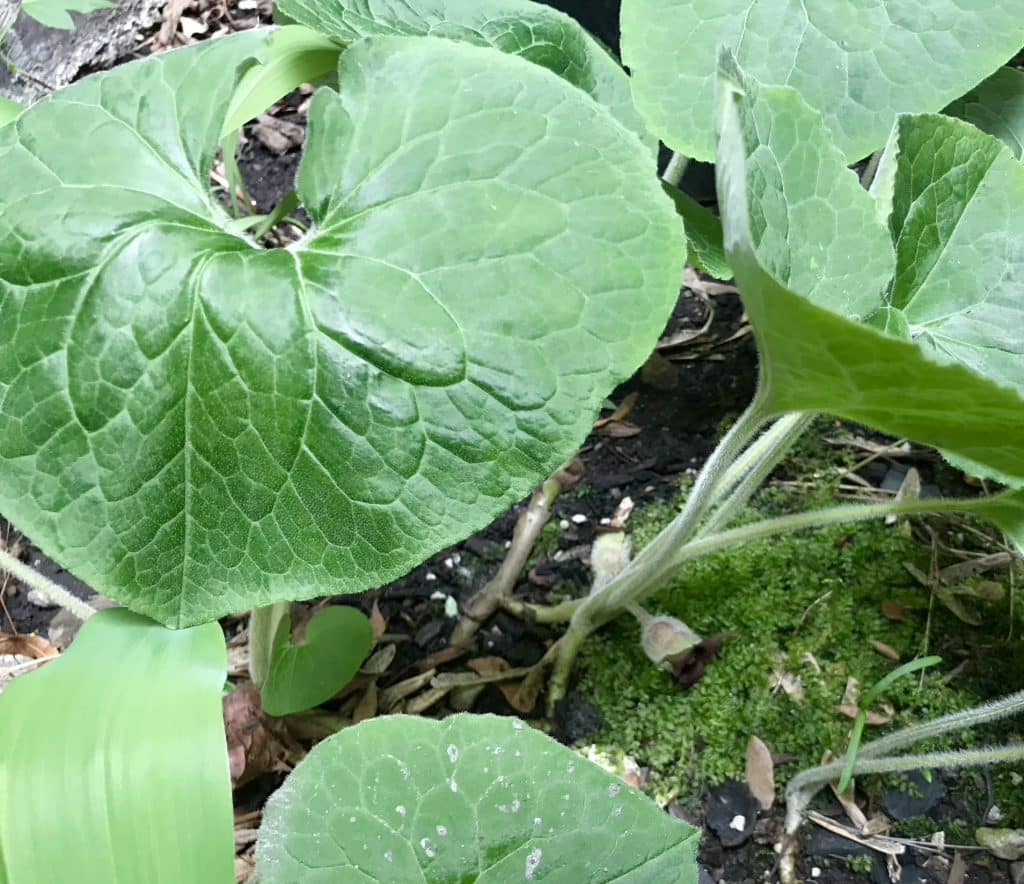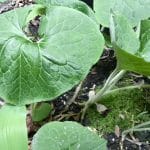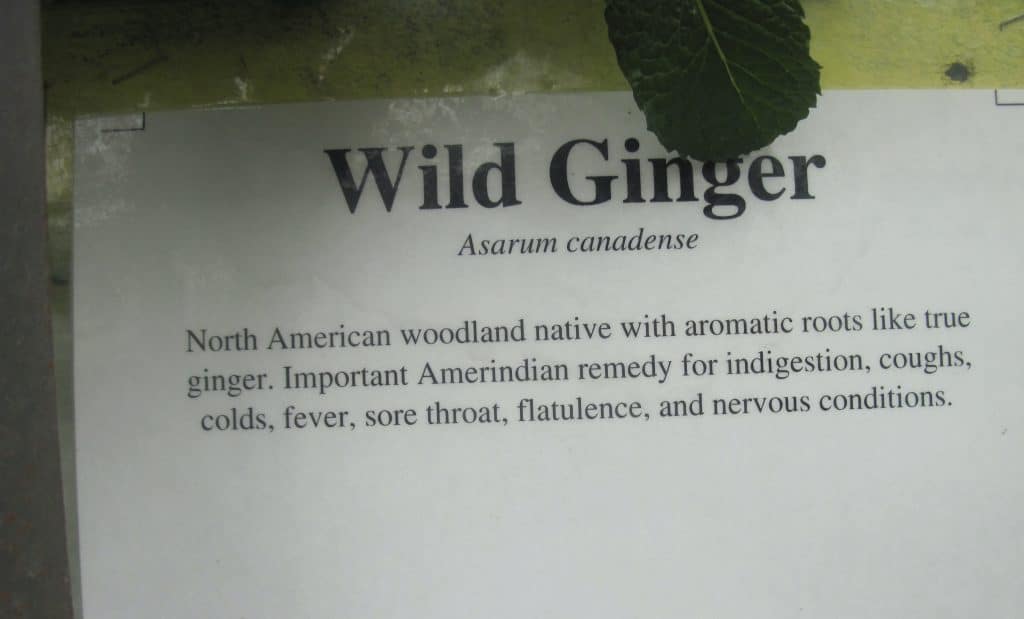Years ago, I planted a couple of wild ginger plants in my shade garden. They are happy there and have grown + spread. I typically just enjoy the plants.... but sometimes I do harvest a little.. and have fun making a mini project or two.. I harvest the roots (rootstalk), which grows along the surface of the garden. The root has a distinct ginger aroma! This is, of course, the reason for the common name. Wild Ginger is not related to the ginger we buy commercially (Zingiber officinale). Do you know this plant?
Wild Ginger is both an edible plant + has medicinal qualities as well.
Wild ginger is a colony-forming, low-lying plant with a very sweet + solitary unusual reddish-brown flower that has three pointed lobes. If you take a peek at the pic below, you'll see the flowers, in early stage.
I will try to include a better pic of the flower, as soon as possible!

Wild ginger can be harvested in the fall, as the leaves are dying back. I am sharing this information early so you can possibly find some plants in your local woodland. Because of the way wild ginger grows and spreads, harvesting the rootstalk of this plant is fairly easy. The rootstalk, or rhizome, grows along the surface of the ground and can be easily pulled up.
Watch for this special plant -- it can be found throughout the eastern United States and Canada in moist, rich woodlands, usually under the shade of deciduous trees. When harvesting wild ginger, only collect a few rhizomes from each colony and always leave more behind than you take. This way, the colony can continue to thrive for years to come.
Wild Ginger Highlights:
There are many healing attributes but the main ones are:
appetite stimulant
carminative
circulatory stimulant
decongestant
diaphoretic
digestive stimulant
emmenagogue,
expectorant (relaxing, stimulating)
febrifuge
uterine tonic
vasodilator (general, neural, peripheral).
It's also a gentle analgesic, anti-bacterial, bronchodilator, immune stimulant + nervine.
(Contact me if you are interested in a larger monograph, please) Also.. check out the SB glossary here if you want to check a 'term'.
My teacher, mentor Michael Vertolli (from the Living Earth School) is an amazing herbalist + I think he has a 'special love' for wild ginger.
He taught us that it's one of his favourite stimulating catalysts for conditions of the female reproductive system. It is primarily used for cramping and absent, sporadic, very light periods and long cycles. It is also used for menopausal symptoms.
We also use it to boost formulae for the respiratory + digestive system, lymphatic conditions as well as liver conditions.
We use it in 10-20% when we use it in a formula. (no higher % as it will be too hot.)
It's used for poor circulation; especially peripheral circulation. It can improve heart function as a gentle cardiac. We can use it for low to moderate fevers, head colds, chest colds + flu. It's an excellent digestive stimulant + improves our digestion overall. It can really help with spasms or cramping of the digestive tract as well as nausea, flatulence or colic. It's an excellent respiratory herb. It can help to clear sinuses. (Wild ginger can combine well with white pine as they balance each other) We an use it successfully with loose coughs, and can be a great expectorant (both relaxing + stimulating). It is a well-respected support for poor lymphatic drainage.
Contraindications: Not recommended in pregnancy, lactation, for infants, or in severe kidney conditions.
Don't use wild ginger for extended periods of time. (2 months... and then a break)
Herbalists tincture the rootstalks + use in formulae (suggestion --not > 20%)
In addition to being an amazing herbal medicine, we can create a few delicious recipes. (as always.. we are only limited by our imagination)
Wild Ginger Syrup
I've only made this a couple of times. It was a hit with all who tried it. Hoping you enjoy it!!
1 cup sugar (typically I choose a coconut or cane sugar as opposed to refined white)
1 cup wild ginger root (washed, cut into 1 inch pieces)
1 cup water
Steam the ginger root for about 20 minutes.
At the same time, add water to a pot + add the sugar.
Bring to a boil, dissolving all the sugar.
Add the steamed ginger root + keep at a gentle boil for 30-40 minutes.
Strain the roots out + reserve the syrup in a clean glass bottle.

Wild Ginger Syrup
Ingredients
- 1 cup sugar typically I choose a coconut or cane sugar as opposed to refined white
- 1 cup wild ginger root washed, cut into 1 inch pieces
- 1 cup water
Instructions
-
Steam the ginger root for about 20 minutes.
-
At the same time, add water to a pot + add the sugar.
-
Bring to a boil, dissolving all the sugar.
-
Add the steamed ginger root + keep at a gentle boil for 30-40 minutes.
-
Strain the roots out + reserve the syrup in a clean glass bottle.
We can use the syrup .. as an addition to an 'adult' beverage/cocktail or we can sip it -- it's delicious; gingery flavour!
Note: you can dry the roots on paper towels and make a kind of " sliced ginger candy " .. I need to experiment with this idea more.
Will report back !!
Remember : when we wildcraft, forage or choose to pick wild plant friends.. We need to ensure we only pick a very small amount from any "colony".
Ideally, after we have 'harvested', it is impossible to tell that we have been there at all ! If you want to purchase Wild Ginger for your shade garden, and grow it yourself, check out Richters Herbs here.

Here's to respecting our green world, learning about our plant allies + carefully choosing some volunteers to bring home + use.
with only green good wishes for our health ~ Carol xo


Leave a Reply